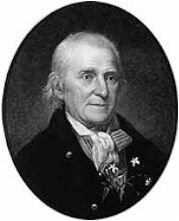
William Bartram
April 20, 1739 - July 22 1823William Bartram was America’s first native born naturalist and artist–the first author of his time to depict nature in his writings from personal experience and scientific observation. Bartram, born in Kingsessing, Philadelphia, Pennsylvania, was the son of famous botanist John Bartram. As a young boy, William would follow his father on journeys to the Catskill Mountains, the New Jersey Pine Barrens, New England, and Florida.
When William became older, he started to develop an increasing role in maintaining his father’s botanical garden by supplying it with many rare flowers and samples. In 1773, Bartram embarked on a four year, 2,400 mile journey through eight southern colonies. Here, Bartram became recognized naming 215 North American birds, for his drawings and observations of the native flora, fauna, and the Native American Indians. He wrote about his adventures in a novel titled Travels Through North & South Carolina, Georgia, East & West Florida, which was published in 1791. The novel became a quick success in America and has been described by scholars as the most astounding verbal artifact of the early republic.
The publication of Bartram’s novel had also made him an immediate success in Europe. His novel influenced many romantic poets and travelers who appreciated his detailed encounters of his journey to subtropical Florida and unexplored southeastern woodland. Later, he classified 140 species of birds breeding in Pennsylvania and even kept the first calendar of bird migration.
At the beginning of the 19th century, Bartram became a mentor for a new generation of naturalists who were eager to explore the new territories that were added to the young nation. He taught nieces and nephews, wrote many essays, anonymously contributed to several works, and helped run the family horticultural business. His most famous contribution of his later career was the illustration for Benjamin Smith Barton’s explanation of the Linnaean system.
William Bartram lived through the War of 1812, but many of his friends and colleagues had died. One of the last from his generation, Bartram placed himself into an extended period of work where he observed, studied the family’s garden in his hometown, and maintained a diary filled with records of bird migrations, flora and fauna life, and the weather.
He wanted to be by himself at this stage in his life. Bartram refused a request to teach botany at the University of Pennsylvania, and declined an invitation from President Thomas Jefferson to lead an expedition up the Red River in the Louisiana Territory. On July 22nd 1823, Bartram died at his home in Kingsessing Pennsylvana, at the age of 84.
William Bartram is known as the Father of Pennsylvania Ornithology. The Bartram Trail Conference (BTC) (https://bartramtrailconference.wildapricot.org/) was created in 1976 to outline Bartram’s southern journey and aims to promote interest in creating trails with botanical gardens along his route.
